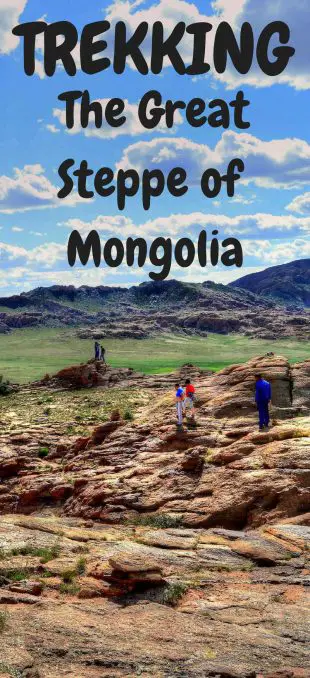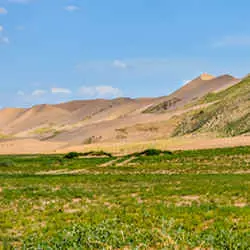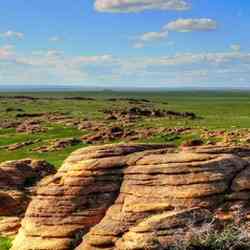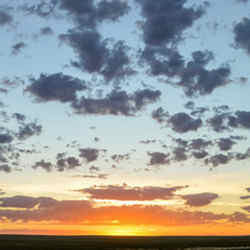Just the word ‘Mongolia’ stirs up some memories of the great Ghingus Khan (pronounced “Chingus”). How he was able to take a country that is more or less twice the size of Texas in the U.S. and become the master of the largest land empire in the history of the world. He ruled everything from Russia, East through Hungary and back, to include all of the countries in SE Asia. He was able to control virtually the entire continent of Asia, except for India. Kublai Khan, his grandson, was able to further the empire by conquering China. He started the Yuan Dynasty in the country.

CURRENT GOVERNMENT INFORMATION |
• die 10.58 years sooner
• are 3.8 times more likely to die in infancy
• make 88.83% less money
• are 23.29% more likely to be unemployed
• spend 97.39% less money on health care
• use 89.03% less electricity
• consume 87.65% less oil
• are 60.74% less likely to be in prison
• are 83.33% less likely to have HIV/AIDS
We started our trip to Mongolia with a few weeks in Ulaanbaatar, the capital city (hereafter abbreviated UB). The city is a huge sprawling mess with 45% of the population living there. The city was built for a population of a few hundred thousand. It has exploded to a population of over a million. In 1998 only 25% of the population lived in UB. That has now doubled without the growth and improvement of an infrastructure to cope with the added people.
The remainder of Mongolians still live their entire lives as nomads with their flocks of sheep, goats, camels, and horses. Oh yes, horses! Throughout the entire country, horses are roaming free in herds from 25 to as many as several hundred. It is simply awesome to see. They are a small horse, like the Spanish Mustangs in the Americas. What they lack in size, they more than make-up for in heart and stamina. During the Naadam Festival (we will discuss that later) they race as far as 30 and 50 kilometers. No thoroughbreds can even think of coming close to that. The horse is and always will be the symbol of Mongolia. The horse is how the great Khan was able to amass such a huge empire.
After uniting the nomadic tribes of the Mongolian plateau, he conquered huge chunks of central Asia and China. At their peak, the Mongols controlled between 11 and 12 million contiguous square miles, an area about the size of Africa.
Our Adventure In Mongolia Begins
The first few days of our trip will take us to several places of religious significance and are located in the Granite Belt of North Central Mongolia. The lush valleys, filled with nomads and their flocks are surrounded by the unique mountains. They look almost like stacks of pancakes in many places with round holes in them. They have what looks like huge air bubbles that were there when the rocks were formed millions of years ago. We will see the Red and White Stupas which are cliffs carved by the wind that appear like cities as you approach them from the valley floor.
This is also the richest area of Mongolia and is filled with mining operations from major players like Rio Tinto and more. Mongolia is rich in all types of minerals like coal and gems and this is a large part of the money that supports the government of the country. Interesting side-note: Every citizen of Mongolia receives a portion of their income from the mining that is done there.
Enough about the country now let us share with you the places we saw and people we met along A Road to Travel in the beautiful country of Mongolia. We will be taking a long trip, some by camel, some by horse but mostly by the best 4 wheel vehicles, I have ever ridden in. The Russian van that are relics from the 1970’s. There are hundreds or even thousands of them in the country. As they wear out, the locals keep rebuilding them. They will easily hold 6 people and all of their gear including tents, sleeping bags, cooking gear and food for your trip. They are high up off of the ground and rarely get stuck in the muddy roads of Mongolia.
No Bushes – No Trees – No Privacy
 We began our ride to the Steppes and at lunch pulled over for our first picnic lunch of many. Laurel and the girls all found out just what life was going to be like with no plumbing, no trees, and no bushes. You just had to walk until you found a hilltop, crossed over and then do your business. A new experience for the Aussie girls, Annie had been working for an NGO in Cambodia so not a huge surprise for her but a wake-up call for Helena and Anna. Helena is studying Chinese in Shanghai and Anna is about to begin her residency training after completing her med school courses.
We began our ride to the Steppes and at lunch pulled over for our first picnic lunch of many. Laurel and the girls all found out just what life was going to be like with no plumbing, no trees, and no bushes. You just had to walk until you found a hilltop, crossed over and then do your business. A new experience for the Aussie girls, Annie had been working for an NGO in Cambodia so not a huge surprise for her but a wake-up call for Helena and Anna. Helena is studying Chinese in Shanghai and Anna is about to begin her residency training after completing her med school courses.
 We are being led by a 60-year-old Mongolian named Baisa (buy-sa) who is our driver and Oyuna (i-you-na) our guide/cook who is a language professor during most of the year at the University of Mongolia. Oyuna is a fountain of information and we could not have been any luckier getting our guides. Baisa is a master of the Russian Van and his van was recently purchased. We are only the second group to use it and it is in perfect mechanical order.
We are being led by a 60-year-old Mongolian named Baisa (buy-sa) who is our driver and Oyuna (i-you-na) our guide/cook who is a language professor during most of the year at the University of Mongolia. Oyuna is a fountain of information and we could not have been any luckier getting our guides. Baisa is a master of the Russian Van and his van was recently purchased. We are only the second group to use it and it is in perfect mechanical order.
Little Rock
 We’ll start with the area known as BAGA GAZRIIN CHULUU or Little Rock to the Mongolians. Located here you will find the granite area of the countryside. At Little Rock, giant rock formations with small piles of stones by the thousands can be seen. These piles of rocks can signify a place of sky-worship or a landmark. Sky-worship was practiced by the locals who choose Shamanism as their religion, although it has been replaced by Buddhism in most of the country. The area is full of caves and was once a site of a large monastery with over 500 monks.
We’ll start with the area known as BAGA GAZRIIN CHULUU or Little Rock to the Mongolians. Located here you will find the granite area of the countryside. At Little Rock, giant rock formations with small piles of stones by the thousands can be seen. These piles of rocks can signify a place of sky-worship or a landmark. Sky-worship was practiced by the locals who choose Shamanism as their religion, although it has been replaced by Buddhism in most of the country. The area is full of caves and was once a site of a large monastery with over 500 monks.
During the time from 1911 to 1952, the country was controlled by Russia and most of the monasteries were bombed and destroyed. The monks were either killed off or if they were young enough, were sent to Russia to work as slave labor building the Trans-Siberia Railroad. The small monastery here at Little Rock is widely thought of as the place the 4th Dalai Lama began his education. After visiting both places we went into a lush green valley to a place with three Gers. A Ger is a round tent with heavy felt linings covered by a waterproof canvas. The nomads are able to live in them year-round to temperatures of -70F or -57C.
Our First Mongolia Campsite
 Our hosts met us as we drove up and we got our first glimpse of the inside of a family Ger. It’s not the Ritz by any means and you instantly find out how these people live with minimal comfort year round in the steppes. We had 5 beds of sorts, little wooden frames with wooden slats and a flat piece of wood on top of them. The mattress consisted of a small pad about a half inch thick, one or two comforters on top of that and (in this case, as in most) no pillow. The few times that we did have a pillow, they were filled with some sort of grain hulls which were very comfortable.
Our hosts met us as we drove up and we got our first glimpse of the inside of a family Ger. It’s not the Ritz by any means and you instantly find out how these people live with minimal comfort year round in the steppes. We had 5 beds of sorts, little wooden frames with wooden slats and a flat piece of wood on top of them. The mattress consisted of a small pad about a half inch thick, one or two comforters on top of that and (in this case, as in most) no pillow. The few times that we did have a pillow, they were filled with some sort of grain hulls which were very comfortable.
Our campsite was in a lush green valley about a mile long and a half-mile wide. There were herds of wild horses roaming at will in the valley. Huge rocks were available to climb just outside of the Ger area for some really nice photos. We had a good mutton and rice meal before retiring to a horse dung campfire for the evening. There is little wood and the dung, after it dries, has no odor and burns slowly. Later in the trip, we had some wood stoves but the wood was gone in an instant, the dung worked out much better. While we were sitting around the fire, a late-arriving van came in to use the third Ger. The owner of the Gers quickly brought out a large metal stove and put it over the fire. A metal cask (much like a beer keg) was filled with smooth round rocks from a riverbed somewhere and allowed to get red hot before an entire leg of mutton was added with potatoes and carrots. They roll the cask around on the ground allowing the rocks to sear and cook the meat and in only a very short time you have Mongolian Bar-B-Que or HOT POT. The other van shared their meal and it was the end of a great day.
Mornings in Mongolia
 Early the second day I got up and sat on top of the large rocks waiting for my first Mongolian sunrise. I loved the quiet, the stillness and the pure nature of Mongolia. It was well worth the wait. The sky was beautiful. As the sun came up, it lit up the rocks on the other side of the valley and the green grass with the horses. A beautiful site and a good way to start our journey to TSAGAAN SUVARGA or the White Stupas.
Early the second day I got up and sat on top of the large rocks waiting for my first Mongolian sunrise. I loved the quiet, the stillness and the pure nature of Mongolia. It was well worth the wait. The sky was beautiful. As the sun came up, it lit up the rocks on the other side of the valley and the green grass with the horses. A beautiful site and a good way to start our journey to TSAGAAN SUVARGA or the White Stupas.
Small Surprise to Begin Day 2
We stopped at a place where a small round hole on the top of one of the rocks had been eroded. Baisa took all 5 of us up and pulled a small ladle out of the hole that was filled with water. We were told that this water would help cure eye problems and to rub it on the outside of our eyes. I did this, then drank a second ladle full, just trying to give it the best chance to work, but so far I still need my glasses.
The roads in Mongolia consist of just two ruts, many times 10 to 20 sets running side by side all ending up at the same place. The roads are wash boarded and rough as all get out and we soon found out what the entire adventure was going to be like. There is little to see besides the granite belt and we were soon in the endless steppes heading to the White Stupas.
 After about a 9 hour ride we pulled into our campsite which was a Ger Village or campground. This was the location of the one hot shower we were to get for the next 7 days. We all had a shower and rested before heading to the stupas. Mongolia is light from 5:00 am till 11:00 pm every day. With only 6 hours of darkness, the days seem endless.
After about a 9 hour ride we pulled into our campsite which was a Ger Village or campground. This was the location of the one hot shower we were to get for the next 7 days. We all had a shower and rested before heading to the stupas. Mongolia is light from 5:00 am till 11:00 pm every day. With only 6 hours of darkness, the days seem endless.
The White Stupas was all it was described to be and more. Beautiful red, purple and yellow cliff faces and the most exquisite humps covering the valley floor, were like a rainbow of colors. We spent hours hiking around the area and climbing to the top for pictures of the Red Stupas, far across the valley.
Ready for Next Leg of Our Adventure in Mongolia
We would visit them the next morning on our way to the Three Beauties which is the location of the only glacier in southern Mongolia. How cool is that! In the middle of the desert, in the middle of Summer, there are remnants of a small frozen glacier. But let’s not get ahead of ourselves. Next installment will be the Glacier Park and the Gobi Sand Dunes.
